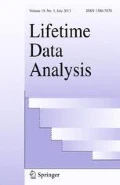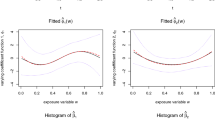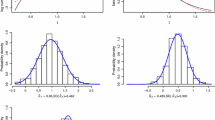Abstract
The nonparametric maximum likelihood estimator for current-status data has been known for at least 40 years, but only recently have the mathematical-statistical properties been clarified. This note provides a case study in the important and often studied context of estimating age-specific immunization intensities from a seroprevalence survey. Fully parametric and spline-based alternatives (also based on continuous-time models) are given. The basic reproduction number R 0 exemplifies estimation of a functional. The limitations implied by the necessarily rather restrictive epidemiological assumptions are briefly discussed.
Similar content being viewed by others
References
A. E. Ades and D. J. Nokes, “Modeling age- and time-specific incidence from seroprevalence: Toxoplasmosis,” American Journal of Epidemiology vol. 137 pp. 1022–1034, 1993.
P. K. Andersen, Ø. Borgan, R. D. Gill and N. Keiding, Statistical Methods based on Counting Processes, Springer Verlag: New York, 1993.
P. K. Andersen and B. B. Rønn, “A non-parametric test for comparing two samples where all observations are either left- or right-censored,” Biometrics vol. 51 pp. 323–329, 1995.
M. Ayer, H. D. Brunk, G. M. Ewing, W. T. Reid and E. Silverman, “An empirical distribution function for sampling with incomplete information,” Annals of Mathematical Statistics vol. 26 pp. 641–647, 1995.
H. D. Brunk, “Estimation of isotonic regression,” In Nonparametric techniques in statistical inference (M.L. Puri, ed.), Cambridge University Press: Cambridge, 1970, pp. 177–195.
I. D. Diamond, J. W. McDonald, and I. H. Shah, “Proportional hazards models for current status data: Application to the study of differentials in age at weaning in Pakistan,” Demography vol. 23 pp. 607–620, 1986.
I. D. Diamond and J. W. McDonald, “Analysis of current-status data,” In Demographic Applications of Event History Analysis (J. Trussell, R. Hankinson and J. Tilton, eds.), Clarendon Press: Oxford, 1992, pp. 231–252.
K. Dietz, “The estimation of the basic reproduction number for infectious diseases,” Statistical Methods in Medical Research vol. 2 pp. 23–41, 1993.
K. Dietz and D. Schenzle, “Proportionate mixing models for age-dependent infection transmission,” Journal of Mathematical Biology vol. 22 pp. 117–120, 1985.
B. T. Grenfell and R. M. Anderson, “The estimation of age-related rates of infection from case notifications and serological data,” Journal of Hygiene, Cambridge vol. 95 pp. 410–436, 1985.
P. Groeneboom, “Brownian motion with a parabolic drift and Airy functions,” Probability theory and related fields vol. 81 pp. 79–109, 1989.
P. Groeneboom, “Discussion on: Age-specific incidence and prevalence: a statistical perspective, by Niels Keiding,” Journal of the Royal Statistical Society A vol. 154 pp. 400–401, 1991.
P. Groeneboom and J. A. Wellner, Information Bounds and Nonparametric Maximum Likelihood Estimation. DMV Seminar, Band 19. Birkhduser Verlag: Basel, 1992.
L. M. Grummer-Strawn, “Regression analysis of current-status data: An application to breast-feeding,” Journal of the American Statistical Association vol. 88 pp. 758–765, 1993.
B. E. Hansen, “Nonparametric estimation of functionals for interval censored observations,” M.Sc. Thesis, University of Copenhagen and Technical University of Delft, 1990.
N. P. Jewell and S. C. Shiboski, “Statistical analysis of HIV infectivity based on partner studies,” Biometrics vol. 46 pp. 1133–1150, 1990.
N. P. Jewell and M. van der Laan, “Generalizations of current status data with applications,” Lifetime Data Analysis vol. 1 pp. 101–110, 1995.
N. Keiding, “Age-specific incidence and prevalence: A statistical perspective (with discussion),” Journal of the Royal Statistical Society A vol. 154 pp. 371–412, 1991.
N. Keiding, “Modern survival analysis methods in infectious disease epidemiology,” In Mathematics applied to biology and medicine. (J. Demongeot and V. Capasso, eds.), Wuerz: Winnipeg, 1993, pp. 205–215.
I. C. Marschner, “Determining the size of a cross-sectional sample to estimate the age-specific incidence of an irreversible disease,” Statistics in Medicine vol. 13 pp. 2369–2381, 1994.
J. W. McDonald and I. D. Diamond, “On the fitting of generalized linear models with nonnegativity parameter constraints,” Biometrics vol. 46 pp. 201–206, 1990.
B. L. S. Prakasa Rao, “Estimation of a unimodal density,” Sankhyā, Series A vol. 31 pp. 23–36, 1969.
D. Rabinowitz, A. Tsiatis and J. Aragon, “Regression with interval censored data,” Biometrika vol. 82 pp. 501–513, 1995.
A. J. Rossini and A. Tsiatis, “A semiparametric proportional odds regression model for the analysis of current status data,” Journal of the American Statistical Association, to appear, 1996.
S. C. Shiboski and N. P. Jewell, “The statistical analysis of the time dependence of HIV infectivity based on partner study data,” Journal of the American Statistical Association vol. 87 pp. 360–372, 1992.
J. Sun and J. D. Kalbfleisch, “The analysis of current status data on point processes,” Journal of the American Statistical Association vol. 88 pp. 1449–1454, 1993.
G. L. Yang and M. N. Chang, “A stochastic model for analyzing prevalence surveys of hepatitis A antibody,” Mathematical Biosciences vol. 98 pp. 157–169, 1990.
Author information
Authors and Affiliations
Rights and permissions
About this article
Cite this article
Keiding, N., Begtrup, K., Scheike, T.H. et al. Estimation from current-status data in continuous time. Lifetime Data Anal 2, 119–129 (1996). https://doi.org/10.1007/BF00128570
Received:
Accepted:
Issue Date:
DOI: https://doi.org/10.1007/BF00128570




